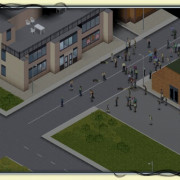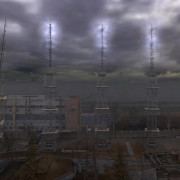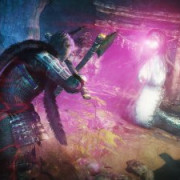34 lost cities forgotten by time
Содержание:
- Великий Зимбабве: Средневековый Замок Африки
- 23. Great Zimbabwe[SEE MAP]
- Order of events
- 9. Ani[SEE MAP]
- 7. Tiwanaku[SEE MAP]
- Гераклион: Затонувший Египетский город
- 2. Angkor[SEE MAP]
- Trivia
- Инструкция по установке мода The Lost Cities
- 31. Skara Brae[SEE MAP]
- Quotes[]
- Krishna’s Sacred City of Dvārakā is another famous lost city
- Palmyra was once a very wealthy merchant city
- 8 Great Zimbabwe: The Medieval Castle Of Africa
- Винланд: Страна Изобилия Викингов
- 3 Heracleion: The Drowned Egyptian City
- Unlocked Descriptions of Known Lost Cities[]
- Tiwanaku was once a cultural center in Bolivia
- 14. Vijayanagara[SEE MAP]
- Calakmul’s great rival Tikal
- 4. Petra[SEE MAP]
- 15. Urgench[SEE MAP]
- 12. Palmyra[SEE MAP]
- Gordium: King Midas’ great capital
- Hvalsey was a Viking settlement on Greenland
- 7. Hattusa was the capital of the once all-powerful Hittite Empire
- Taxila was captured by Darius and later surrendered to Alexander the Great
Великий Зимбабве: Средневековый Замок Африки

Фото: Ив Пикк
В начале 16-го века португальские исследователи начали сообщать, что они слышали легенды о замке в Африке. Туземцы рассказывали, что на земле, ныне известной как Зимбабве, была каменная крепость, возвышавшаяся над деревьями. Местные жители называли его “Симбаоэ”, и даже они не знали, кто его построил.
Один исследователь писал домой: “Когда и кем были воздвигнуты эти здания, поскольку люди этой страны не знают искусства письма, нет никаких записей, но они говорят, что это дело рук дьявола, ибо в сравнении с их силой и знанием им кажется невозможным, чтобы они были делом рук человека».
На протяжении веков европейцы считали Симбаоэ всего лишь суеверной историей. Затем, в 19 веке, они действительно нашли его. Там, в Зимбабве, был массивный замок с каменными стенами высотой более 11 метров (36 футов).
Замок был построен в 900 году нашей эры африканской цивилизацией, которая была потеряна во времени, но они были невероятно связаны. Внутри крепости были найдены реликвии со всего мира, вероятно собранные путем торговли с другими странами. Там были арабские монеты, персидская керамика и даже реликвии китайской династии Мин.
Великая Зимбабве-это больше, чем просто замок. Это доказательство того, что исчезнувшая африканская цивилизация, забытая историей, имела торговые пути, соединявшие ее с Китаем.
23. Great Zimbabwe[SEE MAP]
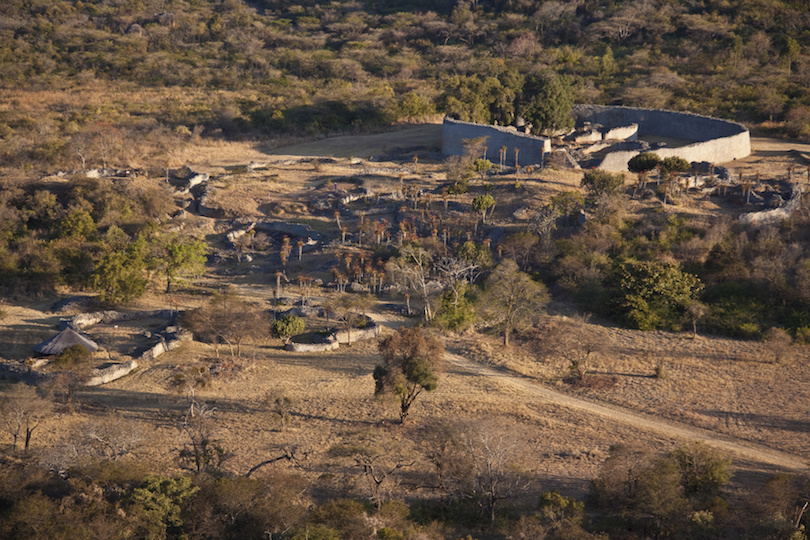
The Great Zimbabwe, is a complex of stone ruins spread out over a large area in modern-day Zimbabwe, which itself is named after the ruins. The word “Great” distinguishes the site from the many hundred small ruins, known as Zimbabwes, spread across the country. Built by indigenous Bantu people, the construction started in the 11th century and continued for over 300 years. At its peak, estimates are that Great Zimbabwe had as many as 18,000 inhabitants. Causes for the decline and ultimate abandonment of the site have been suggested as due to a decline in trade, political instability and famine and water shortages caused by climatic change.
Order of events
The player can gain access to Lost City by using the key obtained in Frostbite Caves — Day 30.
After beating Day 15, the player finds a map which leads to one of the lost temples. The player survives waves of Porter Gargantuars on Day 16.
On Day 32, Dr. Zomboss tells the player to not usurp his discovery of Lost City, and he and his zombies already report their findings to the Eminent Journal Of Missing and Mislaid. After defeating Zombot Aerostatic Gondola, Crazy Dave complains that after all those discoveries he hasn’t found his taco yet, while Penny comforted him and ensured that the search will continue.
9. Ani[SEE MAP]
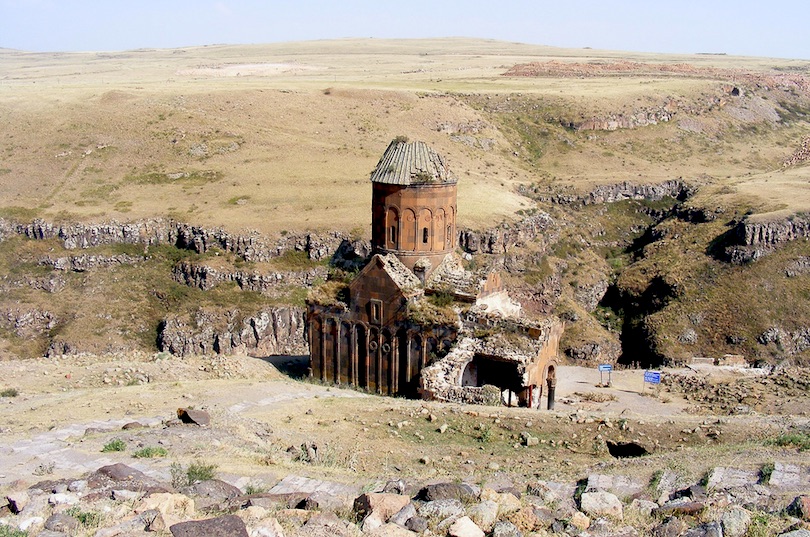
flickr/mx.
Situated along a major east-west caravan route, Ani first rose to prominence in the 5th century AD and had become a flourishing town and the capital of Armenia in the 10th century. The many churches built there during this period included some of the finest examples of medieval architecture and earned its nickname as the “City of 1001 Churches”. At its height, Ani had a population of 100,000 to 200,000 people. It remained the chief city of Armenia until Mongol raids in the 13th century, a devastating earthquake in 1319, and shifting trade routes sent it into an irreversible decline. Eventually the city was abandoned and largely forgotten for centuries. The ruins are now located in Turkey.
7. Tiwanaku[SEE MAP]
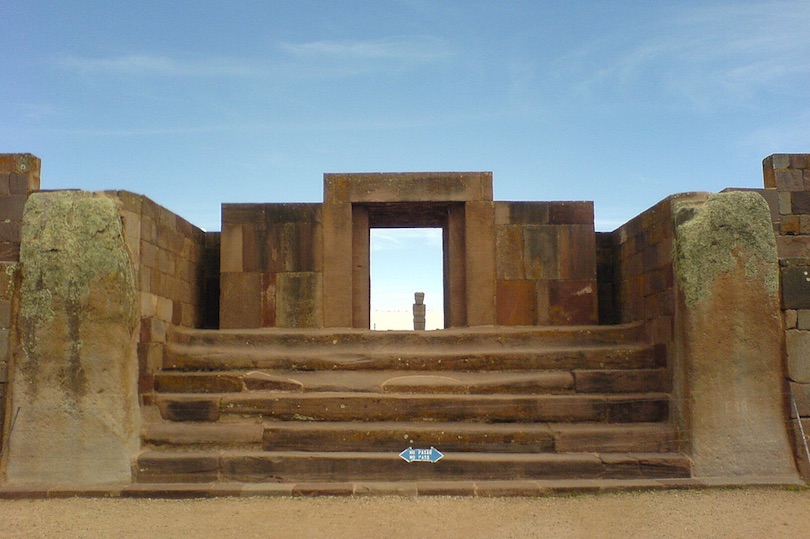
flickr/_tom_
Located near the south-eastern shore of Lake Titicaca in Bolivia, Tiwanaku is one of the most important precursors to the Inca Empire. During the time period between 300 BC and 300 AD Tiwanaku is thought to have been a moral and cosmological center to which many people made pilgrimages. The community grew to urban proportions between the 7th and 9th centuries, becoming an important regional power in the southern Andes. At its maximum extent, the city had between 15,000–30,000 inhabitants although recent satellite imaging suggest a much larger population. Around 1000 AD, after a dramatic shift in climate, Tiwanaku disappeared as food production, the empire’s source of power and authority, dried up.
Гераклион: Затонувший Египетский город
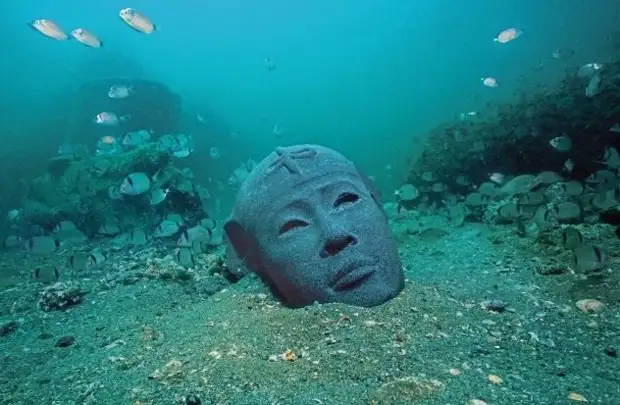
Фоторедактор: Кристоф Геригк/Франк Годдио/Фонд Хилти
Гераклион фигурировал почти в каждом греческом мифе. Это был город, где Геракл сделал свои первые шаги в Африку. Это было место, где Парис из Трои и его похищенная невеста Елена прятались от Менелая перед Троянской войной. И мы понятия не имели, где он.
Как оказалось, была причина, по которой мы не смогли найти один из самых важных портов Египта: он находился под водой. Около 2200 лет назад на Гераклион, вероятно, обрушилось землетрясение или цунами—и он утонул.
Дайверы, плававшие у берегов Египта, наткнулись на него в начале 2000-х. Они нашли странный камень под водой, и когда они подняли его, они поняли, что это был кусок древнего устава. Они нырнули обратно, чтобы посмотреть, что там еще. Вскоре они нашли полные статуи, драгоценности и даже затопленные руины древнего египетского храма.
Большая часть города все еще оставалась нетронутой. Водолазам удалось обнаружить огромные стелы, вывешенные в виде объявлений для посетителей, предупреждающих их иероглифами о египетских налоговых законах. Они нашли статуи древних египетских богов, все еще в их первоначальном виде, с рыбами, плавающими вокруг них. Это был целый затерянный город, вытащенный из глубин воды и возвращенный к жизни.
2. Angkor[SEE MAP]

Angkor is a vast temple city in Cambodia featuring the magnificent remains of several capitals of the Khmer Empire, from the 9th to the 15th century AD. These include the famous Angkor Wat temple, the world’s largest single religious monument, and the Bayon temple (at Angkor Thom) with its multitude of massive stone faces. During its long history Angkor went through many changes in religion converting between Hinduism to Buddhism several times. The end of the Angkorian period is generally set as 1431, the year Angkor was sacked and looted by Ayutthaya invaders, though the civilization already had been in decline. Nearly all of Angkor was abandoned, except for Angkor Wat, which remained a Buddhist shrine.
Trivia
- The post the construction Imps are on seems to have the head of a Snapdragon.
- EA’s official website uses «Lost City of Gold» as the name of this world.
Penny called it «The Fabled Lost City.»
-
Dr. Zomboss
This, however, contrasts the zombies’ looks.
talks normally in this world, hinting that this world is set near the present day.
- The music for Lost City’s Ultimate Battle theme uses the beginning of the Wild West Ultimate Battle theme and has some of the Ancient Egypt and Frostbite Caves
The Brainiac Maniac theme uses some of the music from the Dark Ages version in the beginning.
in the ending.
- Lost City’s Ultimate Battle and Brainiac Maniac use an orchestra and vibraphones in the beginning and end with an acoustic guitar.
- The instruments used to represent Lost City in Modern Day’s themes are the Bassoon and the Cattle Drums.
- A level with the same name and the same theme exists in the 1996 game Crash Bandicoot.
- This world is similar to Merlock’s Temple from the Disney Game Donald Duck: Goin’ Quackers.
- The music that plays on basic levels contains a few areas of silence compared to other worlds’ main themes.
- An area in Zuma’s Revenge!, another PopCap game, is also called Lost City.
- In the Epic Quest Aloe, Salut! and the Beghouled Beyond event, a night version of Lost City is present.
- Before the 5.2.1 update, there was a portal underneath the Gargantuar and Zomboss podiums.
- Before the 5.3.1 version, it was the eighth world on the world map order.
- This is the third world that has beneficial gimmicks, with the first being Wild West, and the second being Far Future.
- At the bottom left corner of the lawn, one can see a statue of Crazy Dave’s head.
- This world has exclusive boss fight music for phase 1. It is where Lost City’s instruments take part with the existing regular Zomboss battle theme.
- Frostbite Caves, Lost City, Modern Day, and Jurassic Marsh are the only worlds that don’t have unlockable plants from Plants vs. Zombies.
- In this world, there are no Last Stand levels.
Инструкция по установке мода The Lost Cities
- Убедись, что у тебя установлен .
- Скачай мод для своей версии игры.
- Закинь его в папку mods, которая расположена в папке с игрой.
Мод Затерянный Город для Майнкрафт 1.12.1 / 1.11.2 позволяет игрокам выжить в заброшенном старом городе
, а не в обычном миром. Когда вы создаете новый мир в начале игры, вы можете выбрать тип мира как «Lost Cities». Вы начнете в старом городе размером с… весь мир. Есть дороги, большие мосты, туннели, подземные туннели… тонны различных типов подземелий с производителями и добычей, а также многое другое.






Minecraft — игра для выживания, которая высоко ценится, потому что игроки могут делать почти все в этом мире. Существует система под названием World Type, которая позволяет игрокам выбирать разные «типы» мира. Однако в Minecraft Vanilla Mojang полностью не применяет этот механизм, поскольку существует только 3 типа World: Basic World, Amplified World и Custom World. Несмотря на то, что вы все еще предоставляете игроку выбор, варианты довольно ограничены.





В The Lost Cities
или Затерянный Город
, хотя у игрока есть еще один вариант, The Lost Cities интереснее обычного мира Minecraft. В «Потерянных городах» игроки могут найти высокие здания с драгоценными добычами и опасными монстрами. Не только это, но вы также можете добавить свои собственные здания в моды и использовать блоки, построенные из других модов.
Мод Lost Cities — генератор мира, который позволяет добавлять постапокалиптические города в Майнкрафт. Вы можете выбрать тип заброшенного города-мира, в котором хотите жить, а мод случайным образом создаст целый мир, полный городов.
Каждый дюйм этого мира — место в городе, который когда-то процветал. Вы увидите здания, которые сейчас разрушаются, и в их стенах полно дыр.

Животные стали жить в городской местности, но здесь нет людей, которые могли бы их отпугнуть.

В настройках, которые появляются при создании мира, можно выбирать разные обстановки. Например, мир может быть наводнен водой:



Здесь большая часть мира находится под водой. Вам придется полагаться на свой ум, чтобы путешествовать по миру, или просто построить несколько лодок, чтобы хотя бы быть рядом с подводными местами. Если вам захочется приключений, можно попробовать найти лут в этих затопленных башнях.

Мир также может находиться во власти джунглей. В такой обстановке можно насладиться пугающей красотой: природа поглощает здания, созданные человечеством.


В этом моде большое количество вариантов для идеальных постапокалиптических миров. Он усложняет игру на выживание, добавляет непревзойденную атмосферу.
31. Skara Brae[SEE MAP]
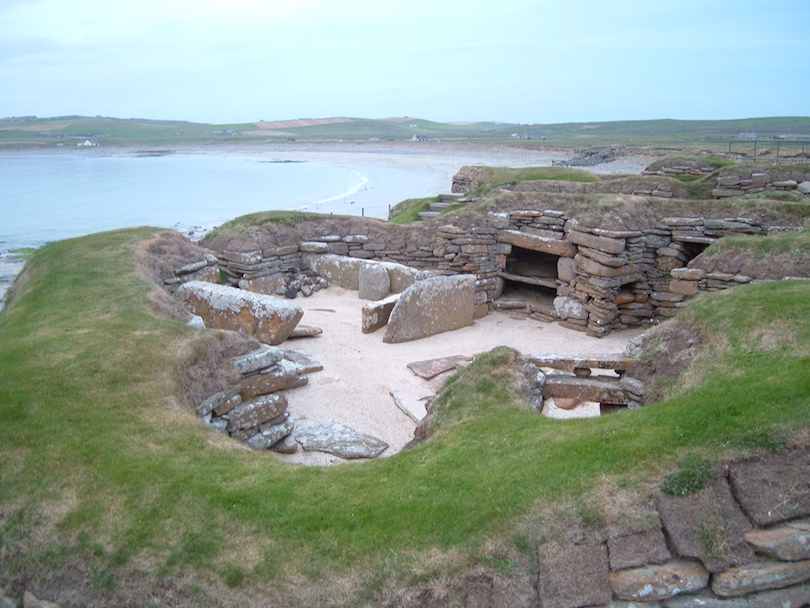
flickr/chatirygirl
Located on the main island of Orkney, Skara Brae is one of the best preserved Stone Age villages in Europe. It was covered for hundreds of years by a sand dune until a great storm exposed the site in 1850. The stone walls are relatively well preserved because the dwellings were filled by sand almost immediately after the site was abandoned. Because there were no trees on the island, furniture had to be made of stone and thus also survived. Skara Brae was occupied from roughly 3180 BC–2500 BC. After the climate changed, becoming much colder and wetter, the settlement was abandoned by its inhabitants.
Quotes[]
—Narration, in Flashback
| Places | ||||
|---|---|---|---|---|
|
Krishna’s Sacred City of Dvārakā is another famous lost city

is a recently rediscovered Hindu, Jainist, and Buddhist sacred city. It forms one of the so-called Sapta Puri, or seven sacred cities, of Hinduism as was the legendary home of the God Krishna.
According to legend, the city was destroyed during a huge battle between Krishna and King Salva. The city was annihilated by blasts of energy never to be seen again.
Many millennia later, during the 1980s, Indian scientists found the ruins of a city near to where legend described it to be. It is now thought that the city could have been built around 9,000 years ago.
Advertisement
If true this would make it one of the oldest cities on Earth.
Palmyra was once a very wealthy merchant city

or «City of Palm Trees» used to be an influential and wealthy city located in present-day Syria. Some archaeological finds suggest it may have Neolithic origins, but it was first mentioned in the 2nd century BC.
It was eventually conquered by various external powers, including the Romans in the 1st century AD.
The Palmyrenes were renowned and successful merchants who established colonies all along the silk road. After a brief rebellion, the city was leveled by Emperor Aurelian and partially rebuilt by Diocletian.
It was later captured by Muslim Arab invaders in 634 AD and declined under Ottoman Rule to the point of virtual abandonment. The historic city was later rediscovered as an archaeological site by European travelers in the 17th century.
8 Great Zimbabwe: The Medieval Castle Of Africa
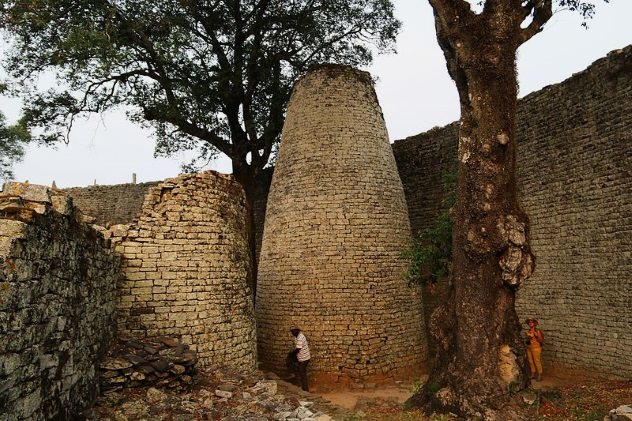
Photo credit: Yves Picq
In the early 16th century, Portuguese explorers started reporting that they’d heard legends about a castle in Africa. In the land today known as Zimbabwe, the natives told them, was a stone fortress that towered over the trees. The locals called it “Symbaoe,” and even they didn’t know who had built it.
One explorer wrote home, “When, and by whom, these edifices were raised, as the people of the land are ignorant of the art of writing, there is no record, but they say they are the work of the devil, for in comparison with their power and knowledge it does not seem possible to them that they should be the work of man.”
For centuries, Europeans thought Symbaoe was just a superstitious story. Then, in the 19th century, they actually found it. There, in Zimbabwe, was a massive castle with stone walls more than 11 meters (36 ft) tall.
The castle was made in AD 900 by an African civilization that has been lost to time—but they were incredibly connected. Inside the fortress, relics were found from all around the world, likely gathered by trading with other countries. There were Arab coins, Persian pottery, and even relics from the Chinese Ming dynasty.
Great Zimbabwe is more than just a castle. It’s proof that a lost African civilization, forgotten to history, had trade routes that connected all the way to China.
Винланд: Страна Изобилия Викингов

Фоторедактор: Клинтон Пирс
В 1073 году немецкий священнослужитель по имени Адам Бременский обратился к датскому королю Свену Эстридссону. Эстридссон рассказала ему , что викинги переплыли Атлантический океан и нашли далекую страну, где все растет беспредельно. “Он называется Винланд, — сообщил жрец, — потому что виноградные лозы растут там сами по себе.
Он был не единственным, кто рассказывал эту историю. Викинги сами передавали его по наследству, говоря, что они сражались с местными жителями, которых они называли скрелингарами. Скрелингары, говорили они, одеваются в белые одежды и живут в пещерах и норах. Когда они нападали, они несли длинные шесты и атаковали, выкрикивая громкие боевые кличи.
Винланд считался мифом о викингах на протяжении многих веков, даже после того, как испанцы достигли Америки. Так продолжалось до 1960-х годов, пока мы не убедились, что они говорят правду. Затем в Л’Анс—о-Медоуз в Ньюфаундленде, Канада, археологи обнаружили остатки поселения викингов, построенного в 11 веке-Винланд, о котором они рассказывали так много историй.
3 Heracleion: The Drowned Egyptian City
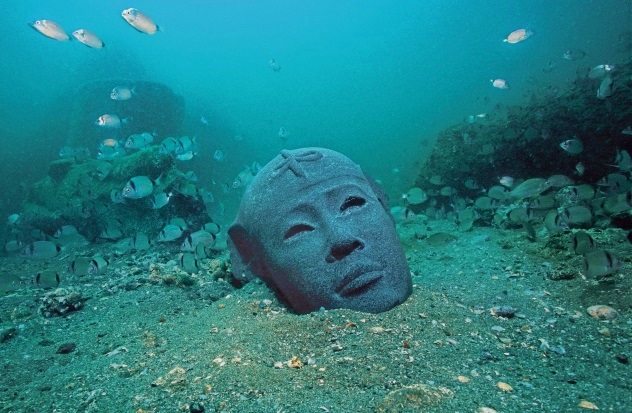
Photo credit: Christoph Gerigk/Franck Goddio/Hilti Foundation
Heracleion showed up in almost every Greek myth. It was the city where Heracles took his first steps into Africa. It was the place where Paris of Troy and his stolen bride Helen hid from Menelaus before the Trojan War. And we had no idea where it was.
As it turned out, there was a reason we couldn’t find one of Egypt’s most important ports: It was underwater. About 2,200 years ago, Heracleion was likely hit by an earthquake or a tsunami—and it drowned.
Divers swimming off the coast of Egypt stumbled upon it in the early 2000s. They found a strange rock under the water, and when they brought it up, they realized that it was a piece of an ancient statute. They dove back in to see what else was there. Soon, they’d found full statues, jewels, and even the drowned ruins of an ancient Egyptian temple.
A massive part of the city was still intact. Divers were able to find huge steles put up as notices to visitors, warning them, in hieroglyphics, of Egyptian tax laws. They found statues of ancient Egyptian gods, still in their original form, with fish swimming around them. It was an entire lost city, pulled from the depths of the water and brought back to life.
Unlocked Descriptions of Known Lost Cities[]
Splendor Plains: Elwin’s residence is just as bright and bold as his fashion sense, and every pane of his widowed walls is set with a different color of glass. But the architecture is also surprisingly sleek and modern, with a flat roof and lots of sharp angles. And while the décor is some what sparse there are plenty of «Elwin» touches-like the room holding his stuffed animal collection and the tunnels visible under the glass floor, which allow his pet banshee(Bullhorn) to scurry wherever his little heart desires. The house is bordered by forest on one side and ocean on the other, providing Foxfire’s resident physician with a variety of peaceful views to enjoy after stressful days in the Healing Center (most of which involve complicated injuries suffered by Sophie Foster).
Wanderling Woods: As the Lost Cities’ only graveyard, the Wanderling Woods is a place of peaceful silence, filled with carefully arranged, incredibly special trees. Wanderlings are planted with the DNA of someone deceased in order to grow with hints of their physical attributes. As a result, no two Wanderlings are alike, and each is labeled with a sign to indicate the life being memorialized- though there are three Wanderlings that were planted prematurely: Sophie Foster’s, Dex Dizznee’s, and Alden Vacker’s. Only elves may enter the Wanderling Woods (unless special permission is granted by the Council), and a golden sign arches over the entrance reminding visitors that «those who wander are not lost.» And while some might comment on how few trees grow in the woods-and claim it as proof that death is rare in the Lost Cities-those mourning loved ones would likely argue that there are still far too many Wanderlings.
Tiwanaku was once a cultural center in Bolivia

was a pre-Columbian settlement that can be found in Western Bolivia. Its original name has been lost to the ages, as its inhabitants did not have a written language.
Tiwanaku is thought to have been inhabited by peoples who probably spoke the Puquina language. It is thought that the site was inhabited from as early as 1500 BC.
The city reached its height between 300 BC and 300 AD when it appears to have been a cultural center. Around 1000 AD, the city fell into decline and was abandoned, as climatic changes forced the inhabitants to leave.
It was first recorded by Europeans in 1549, by Spanish conquistador Pedro Leon, whilst he was searching for the Inca capital.
14. Vijayanagara[SEE MAP]
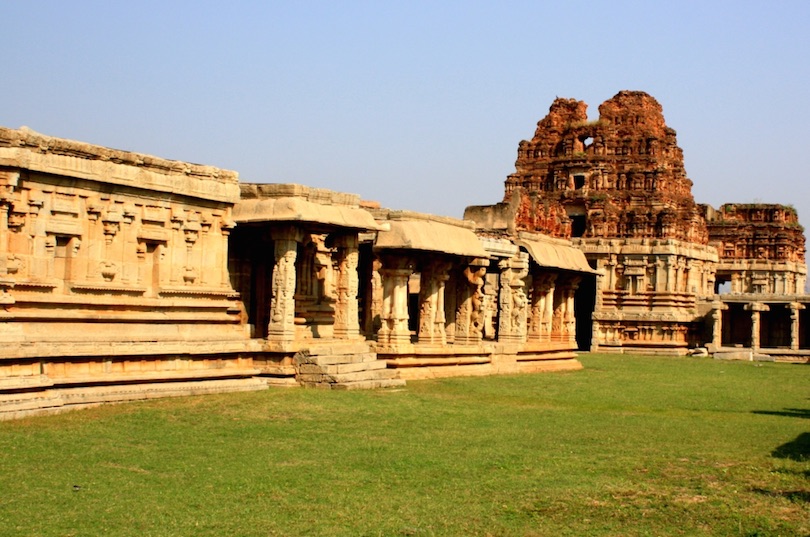
flickr/pcsjith
Vijaynagar was once one the largest cities in the world with 500,000 inhabitants. The Indian city flourished between the 14th century and 16th century, during the height of the power of the Vijayanagar empire. During this time, the empire was often in conflict with the Muslim kingdoms. In 1565, the empire’s armies suffered a massive and catastrophic defeat and Vijayanagara was taken. The victorious Muslim armies then proceeded to raze, depopulate, and destroy the city and its Hindu temples over a period of several months. Despite the empire continuing to exist thereafter during a slow decline, the original capital was not reoccupied or rebuilt. It has not been occupied since.
Calakmul’s great rival Tikal

was one of the largest Mayan cities between 200 and 900 AD, with a population of around 100,000 — 200,000 inhabitants. It is thought to have been called Yax Mutal and can be found in the rainforests of Guatemala.
It was once the capital of a state that would become one of the most powerful kingdoms in Mayan civilization. Some finds suggest the city was occupied as early as the 4th century BC, but it reached its full power during Europe’s middle ages.
The city became a victim of its own success when its demand for timber led to deforestation, erosion, and subsequent famine. Between 830 AD and 950 AD, its population plummeted and Tikal was eventually deserted.
Tikal was reclaimed by the Guatemalan rainforest until the ruins were uncovered by European gum snappers in the mid-1800s.
4. Petra[SEE MAP]

Petra, the fabled “rose red city, half as old as time”, was the ancient capital of the Nabataean kingdom. A vast, unique city, carved into the side of the Wadi Musa Canyon in southern Jordan centuries ago by the Nabataeans, who turned it into an important junction for the silk and spice routes that linked China, India and southern Arabia with Egypt, Greece and Rome. After several earthquakes crippled the vital water management system the city was almost completely abandoned in the 6th century. After the Crusades, Petra was forgotten in the Western world until the lost city was rediscovered by the Swiss traveler Johann Ludwig Burckhardt in 1812.
15. Urgench[SEE MAP]

flickr/martijn.munneke
Formerly situated on the Amu-Darya River in Uzbekistan, Ürgenç or Urgench was one of the greatest cities on the Silk Road. The 12th and early 13th centuries were the golden age of Ürgenç, as it became the capital of the Central Asian empire of Khwarezm. In 1221, Genghis Khan razed Urgench to the ground. Young women and children were given to the Mongol soldiers as slaves, and the rest of the population was massacred. The city was revived after Genghis’s destruction but the sudden change of Amu-Darya’s course to the north forced the inhabitants to leave the site forever.
12. Palmyra[SEE MAP]
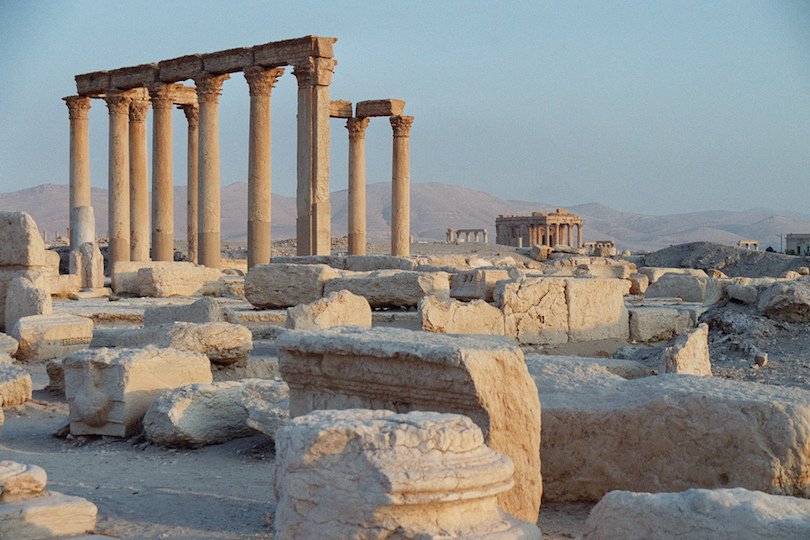
flickr/A travers
For centuries Palmyra (“city of palm trees”) was an important and wealthy city located along the caravan routes linking Persia with the Mediterranean ports of Roman Syria. Beginning in 212, Palmyra’s trade diminished as the Sassanids occupied the mouth of the Tigris and the Euphrates. The Roman Emperor Diocletian built a wall and expanded the city in order to try and save it from the Sassanid threat. The city was captured by the Muslim Arabs in 634 but kept intact. The city declined under Ottoman rule, reducing to no more than an oasis village. In the 17th century its location was rediscovered by western travelers.
Gordium: King Midas’ great capital

, or Górdion (pronounced Gor-di-yon) in Turkish, was the capital city of the ancient Phrygian Empire. Located in Asia Minor, it is roughly 47 miles (75 km) SW of Ankara.
The city lies on what was once the ancient road between Lydia and Assyria that crossed the Sangarius River. Gordium’s most famous ruler was the quasi-legendary King Midas.
Gordium was sacked by the Cimmerians and subsequently abandoned in around 800 BCE but was rebuilt by the Persians.
Alexander the Great is said to have visited the city and solved the puzzle of the Gordian Knot, which said that whoever could loosen the knot would rule Asia — Alexander is said to have solved this problem by simply cutting the knot.
The forgotten city was rediscovered and excavated in 1900 by Gustav and Alfred Korte, and later by the Pennsylvanian Museum, between 1950 and 1973.
Hvalsey was a Viking settlement on Greenland

, aka ‘Whale Island’, is a long-lost Viking settlement located near Qaqortoq, Greenland. It is, to date, the largest and best-preserved example of Norse ruins in what is known as the Eastern Settlement.
It was settled around 1000 AD by Norse farmers who were thought to have arrived from Iceland. The site was probably home to about 4,000 people during its height.
The Western Settlement would be abandoned in the 14th century, with Eastern Settlement lasting a little longer before also being abandoned.
Records exist of a wedding being held in the settlement’s church in 1408. This was the last record of any habitation of the area.
The site was rediscovered in 1721 by a Danish missionary.
7. Hattusa was the capital of the once all-powerful Hittite Empire

The Hittite capital of near modern Boğazkale, Turkey, was lost to ravages of time for millennia. The city was sacked and the Hittite Empire collapsed during the so-called Bronze-Age collapse around 1200 BC.
This catastrophic event is, by some, thought to have begun with an invasion of the so-called «Sea Peoples» that also attacked and raided cities of the ancient Egyptians at around the same time. But it is likely that the city was finally destroyed by the neighboring Kashka, a bitter enemy of several centuries’ standing.
The city was subsequently abandoned and forgotten. It is thought to have once housed around 45,000 people during its height.
Advertisement
Hattusa was rediscovered in the 20th century by German archeologists. The team found a literal treasure trove of clay tablets with writings ranging from legal codes to literature.
Taxila was captured by Darius and later surrendered to Alexander the Great

, aka Takshashila, is a rediscovered ancient city in northern Pakistan. The ruins are situated near modern Taxila in the Punjab region of Pakistan roughly 35 km (22 miles) NW of Rawalpindi.
The ancient city was captured by the Persian king, Darius the Great in 518 BC and later surrendered to Alexander the Great. It would go through a period of rule by various other conquerors before becoming an important Buddhist site.
It is thought to have been founded around 1000 BC; it would become an important city in the region owing to its position on East-West trade routes.
It would later undergo a period of decline until it was finally destroyed by the Huns in the 5th century AD. The city was rediscovered by Alexander Cunningham in the mid-19th century.
Advertisement
